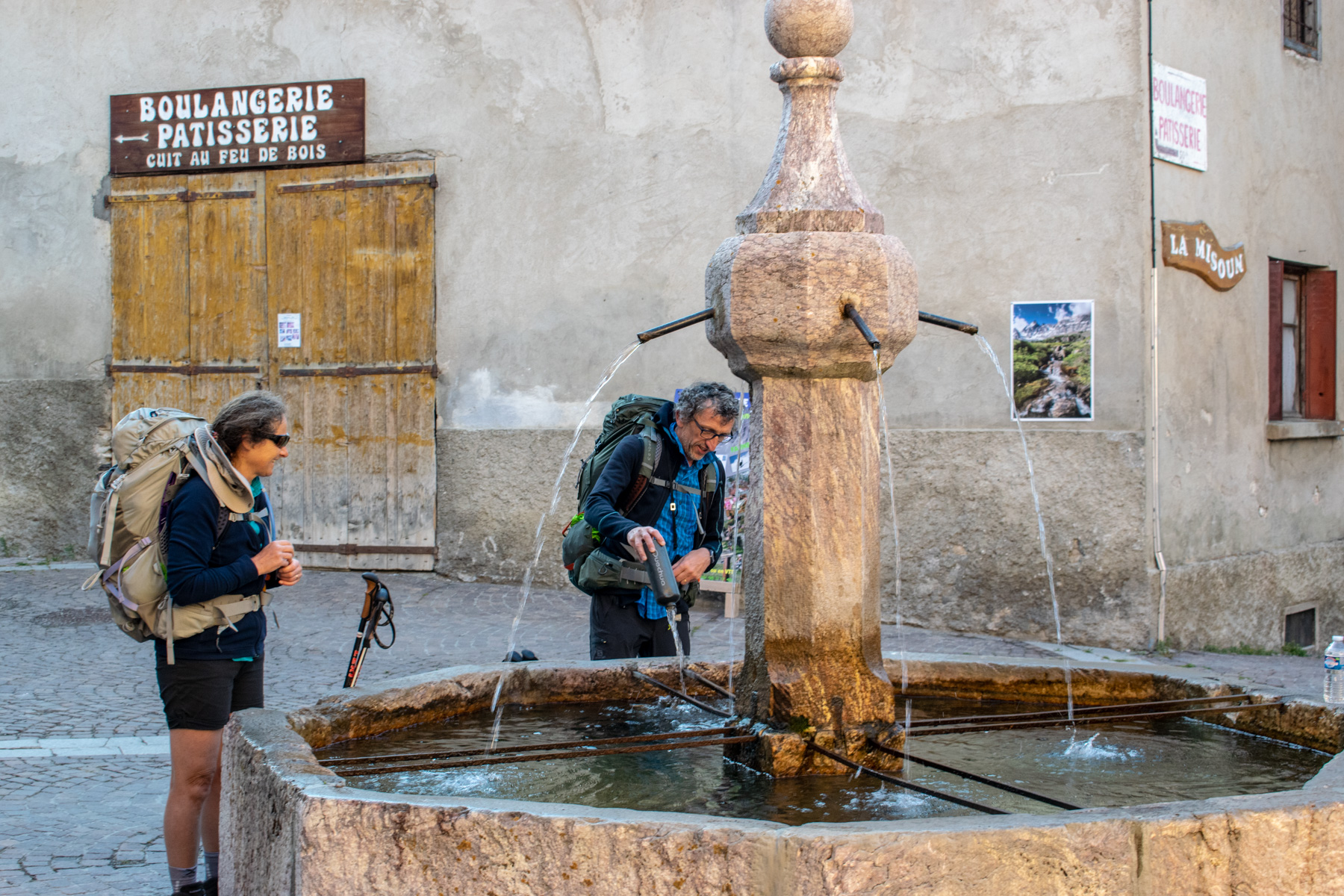Day Four Ceillac (1639m) to Saint-Véran (2020m). 8 miles 13km 1289m Ascent, 908m Descent
Following our day of R & R, we slipped into the alpine walking routine of breakfast at seven o’clock, on the road by eight. We purchased fresh bakery supplies from the crêperie, (we already had a wonderful looking Quiche Lorraine baked in its own little wooden box stashed away in my pack), and filled our water carriers from the village drinking fountain.
We had been sat the previous night with a lovely couple, who, poor things, were placed next to us for every meal for the duration of our walk together, Lawrence and Stephane. Stephane was a kindred spirit, hating to see any smears of tasty food in the dishes at mealtime – we would spar for the last pieces of baguette to mop up with. This morning we set off and loosely walked together.
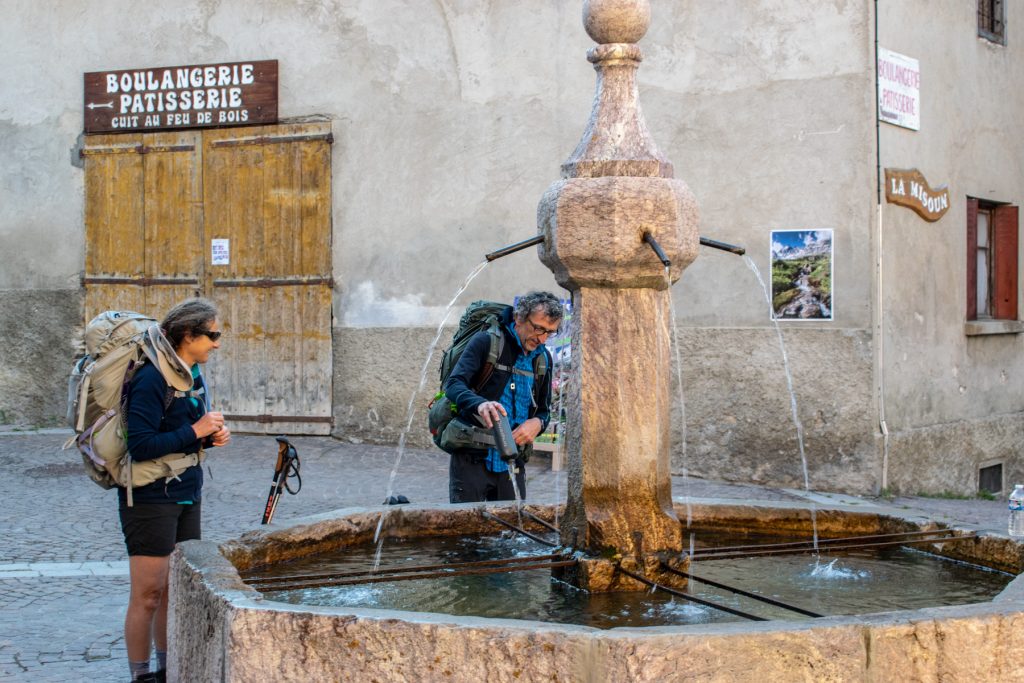
Kit Comment Drinking-wise the split between camelback style (FW uses an Osprey 2.5l hydration reservoir that goes with her backpack.) and water-bottles was pretty even. Although I gather that insulated camelbaks are now available, at least in the US- I would still prefer a water bottle. Why? because I cherish the ‘ceremony of appreciation’ that comes with stopping to drink, and to take in the view. My personal view is that we would be missing out on one of life’s greatest pleasures if God had created us with drip hydration. I am wary of the new style of insulated water bottles, simply because of the extra weight involved, but at some point will do some tests to find the lightest for you oh best beloved.
I have seen no research but have a gut-feeling that periodic drinking allows for better body performance in that the cells release water along with waste, whereas continuous hydration does little or no flushing of the cells – but I’m probably wrong.
Our route took us up through the village into a valley hidden from Ceillac, along an un-metalled road. We were on the ‘sunny-side’ of the valley, a blessing as it was initially rather cool. Halfway along the road we reached a chapel at a tiny hamlet – Le Villard. We were warm enough by this point to justify a halt and perusal of the chapel while removing a few layers.

The hillside sloped upwards to our left, scrubby grass, dotted with the abundance of various wild flowers we had become happily used to, and stubby larch. The shady side of the valley was entirely clad with larch forest.
We turned from the track onto a zigzag path to the Col de Estrinques at 2651m. The ascent to the col was one of increasing warmth, fewer trees, and shorter grass, and it seemed brighter flowers. The view behind revealed another mountain ridge peeking over the tree-clad hillside, defined by bare rock with patches of snow, white enough to make to make a washing-powder advert.
Our bodies were better prepared for the trek, the day-off, along with the various lotions and potions we’d applied and imbibed had worked wonders. Kit Comment – Creams and lotions

One benefit of doing the Tour de Queyras in an anti-clockwise direction is that most of the ascents are on the southern slopes and being in the northern hemisphere means that these are gentler than the northern side, so the regime was invariably up the ‘gentle’ side and down the ‘definitely not gentle’ side.
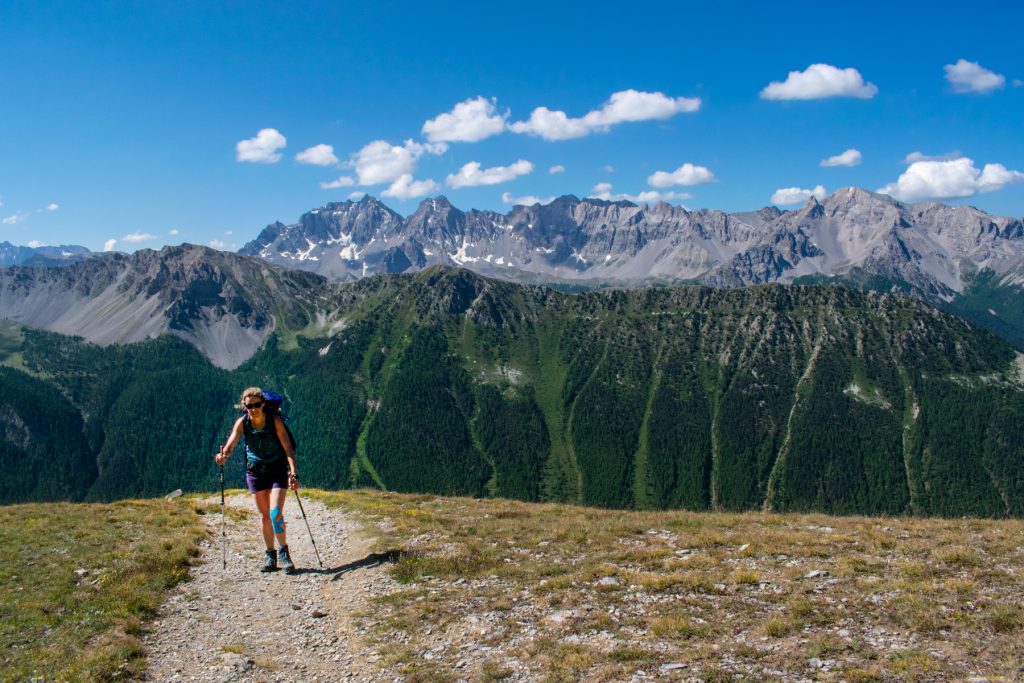
On Reaching the Col, we hunkered down on a sunny rock a few yards down on the north side of the col, sheltered from the wind that had built up as the hillside behind us responded to the heat. We were surrounded by the usual myriad of short flowers on short alpine turf, at this altitude gentians and violas appeared in drifts, bright blue and lilac, with creamy white saxifrage peeking out from cracks in the rock. Oh and about a million and a half others saying “hi look at me”.
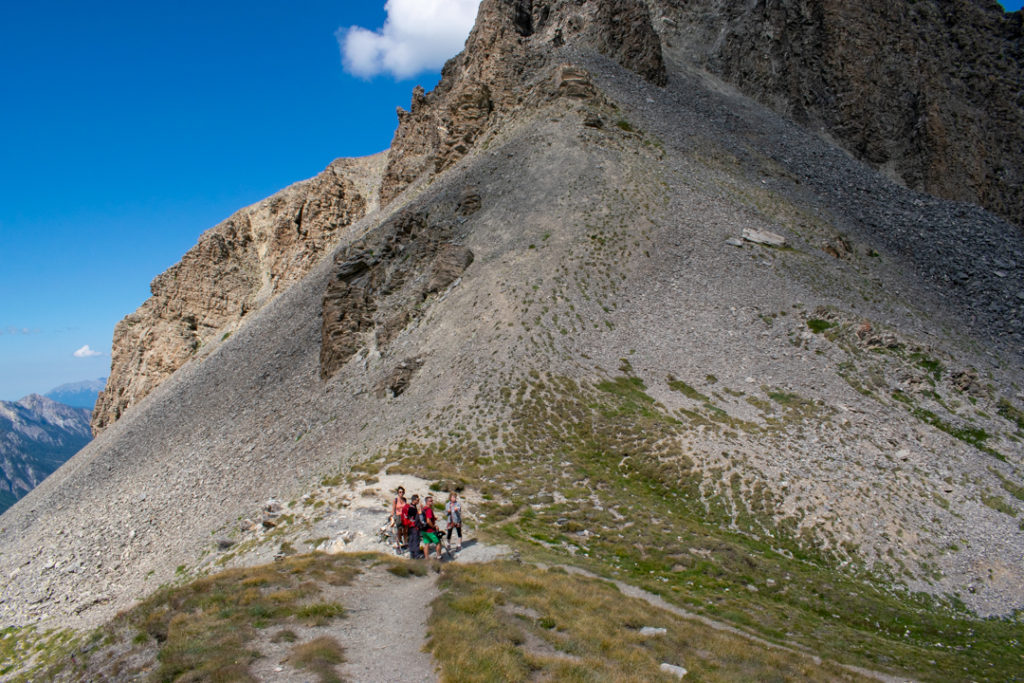
We ate our most excellent Quiche, the remainder of the tomatoes bought before we started, and some local cheese. Oh, and I savoured the last of the fresh milk bought in the village that morning, still with the touch of cold that makes it the most refreshing of drinks.
Before long the peace was disturbed by the busy tinkling of bells, like someone calling for staff in a large house. The bleating and baa’ing as a herd of sheep and goats arrived a few hundred feet below, this explained the bells and the lack of a butler panting up the hillside with ice-bucket of champagne!
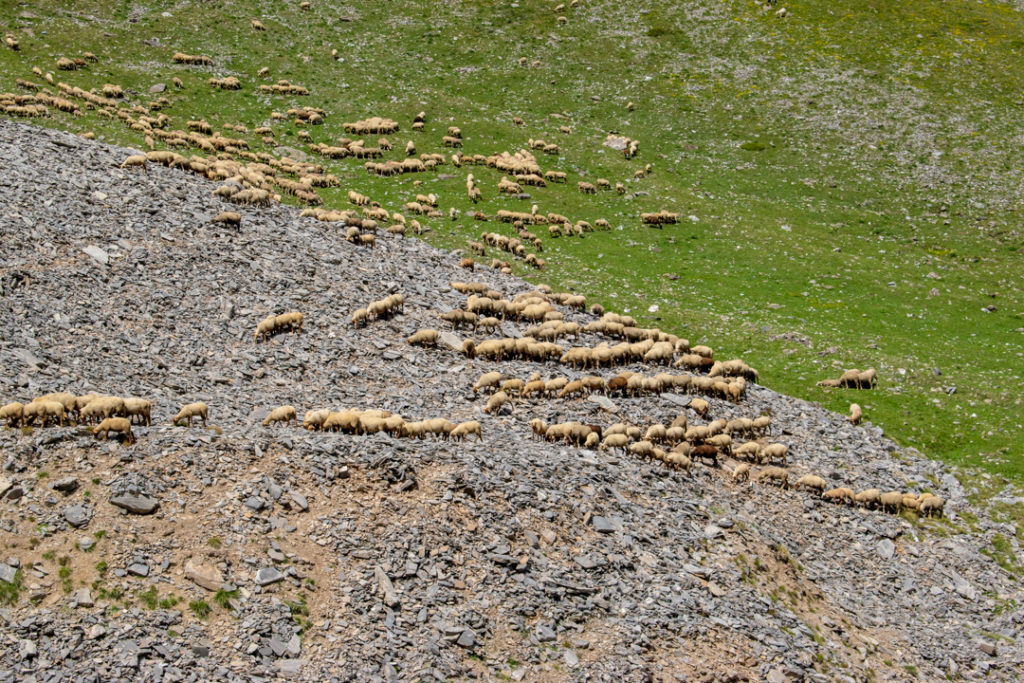
It was easy to see why the turf is short, a flock of a couple of hundred nibblers has quite an effect, and quite a lot of ‘fertiliser”!
We continued downhill, finding yet new flowers, a favourite being a type of thistle, later identified as the Splayed Thistle Eryngium Alpinus, that looks not only as if Tigger has stepped into real life and bounced on it, but it’s cream centre suggested an application of bleach. It’s flowers, as we later saw, were huge by alpine standards.
The way down was relentlessly steep and we took advantage of a path-side plunge pool to soothe our weary feet. The initial presence of a group of young men stripped to their boxers may explain FW’s sudden limp and need to stop.
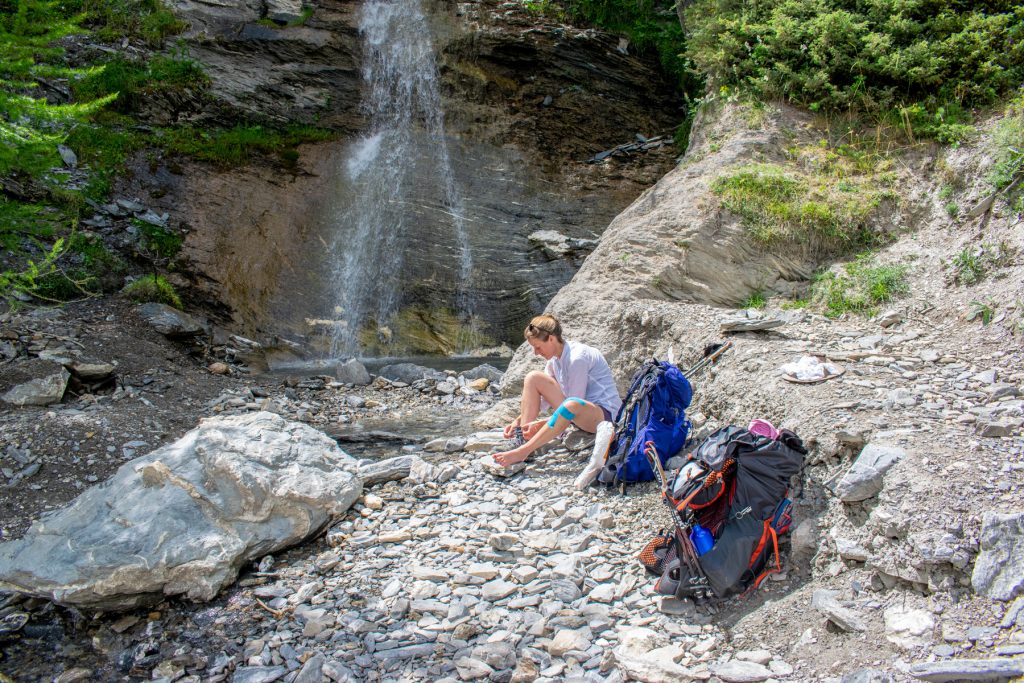
Crossing a patch of gravel I espied a rather large creepy crawly in the form of a bright red and black bodied spider. Later identified as a male Ladybird Spider (Eresus sandaliatus), it was some miles out of it’s recognised area of Italy, but we were not far from the border so forgave it’s bureaucratic bungle.
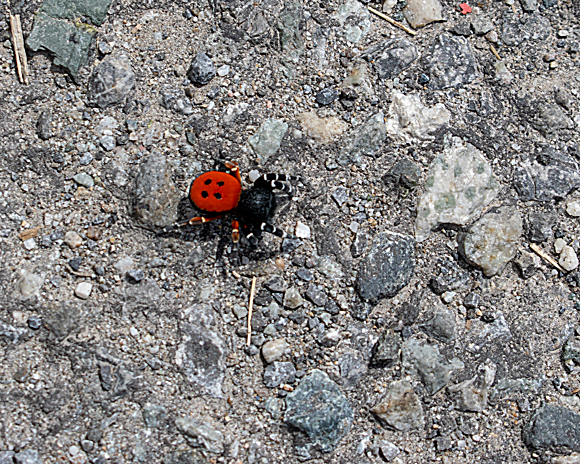
Our next refuge was in Saint Véran (2042m); the highest inhabited village in Europe and designated one of the Most Beautiful Villages of France. It displays a fairly unique building style, which I think may be of interest to some followers, so will include this précise:
“The ground floor consists of stone walls some 50-70 cm thick. Overlying this there is an upper part called “Fuste” is made of logs stacked and crossed at the corners. It was used to dry and store the fodder for the animals, during the long winter months. This building is connected to another smaller stone built ‘cassette’, and it is here, being relatively safe from fires, that crafts, workshops took place and food reserves were kept. Parents, grandparents, and young children slept in the stable, while older children slept in one or two rooms on the floor of CASET. Inside the house everyone was able to do almost everything by way of making and repairing agricultural tools, small furniture and to make modest repairs.
Some work demanded more specialisation, so there were leatherworkers who made and repaired shoes, harnesses, saddles and collars for animals, and blacksmiths for shoeing the many mules and also mads keys, locks, and nails.”
We stayed at the Gîte de Gabelous; one of these very old stone and wooden buildings, unique to the rigorously protectedarea. We had our own chambre, there was a wood-fired hot tub with view, from which we emerged smelling of wood-smoke, and feeling wonderful. Dinner was a five-course meal and fourteen of us crowded round a large table was a recipé for a jovial atmosphere, and Stephane got to mop out the soup tureen.
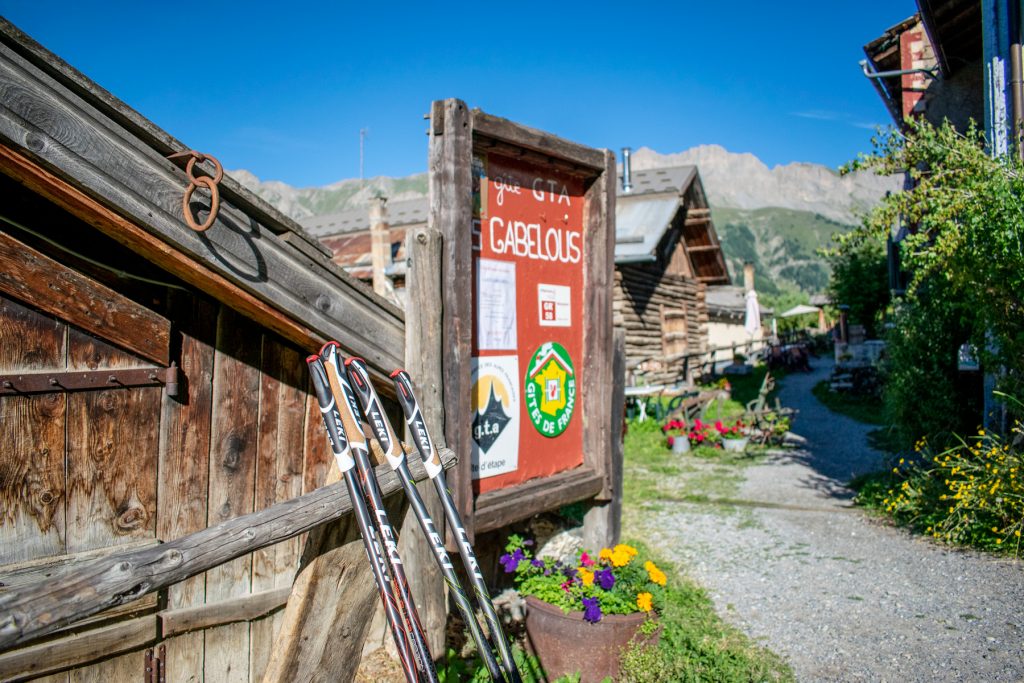
It is best to see this amazing village when the crowds have returned to their cars and trundled off down valley. It’s worth reading the tourist information, and fully absorbing the scene invoked by the old photographs on display. There is a sort of sometimes working museum which was a bread oven, and the village has a number of watering points in the form of circular wooden tanks with water pouring from a pipe on a post set in the middle.
It was in this village that we were introduced to larch-flower products, namely a mélèze syrup and a liqueur mélèze, both produced from the little pink flowers that appear on larch trees in the spring, and would otherwise turn into cones. I’m not sure whether the liqueur or the cones were first in God’s mind as He spoke creation into being, but I have a sneaky feeling the cones came second, or even third. We enjoyed both the syrup and the liqueur!
And so to bed.
